Radiologist Resume Examples
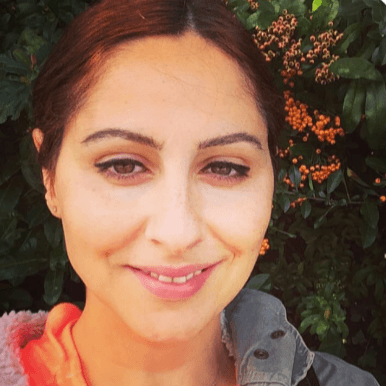
Jul 18, 2024
|
12 min read
Enhance your radiologist resume: How to showcase skills that truly resonate.
Rated by 348 people
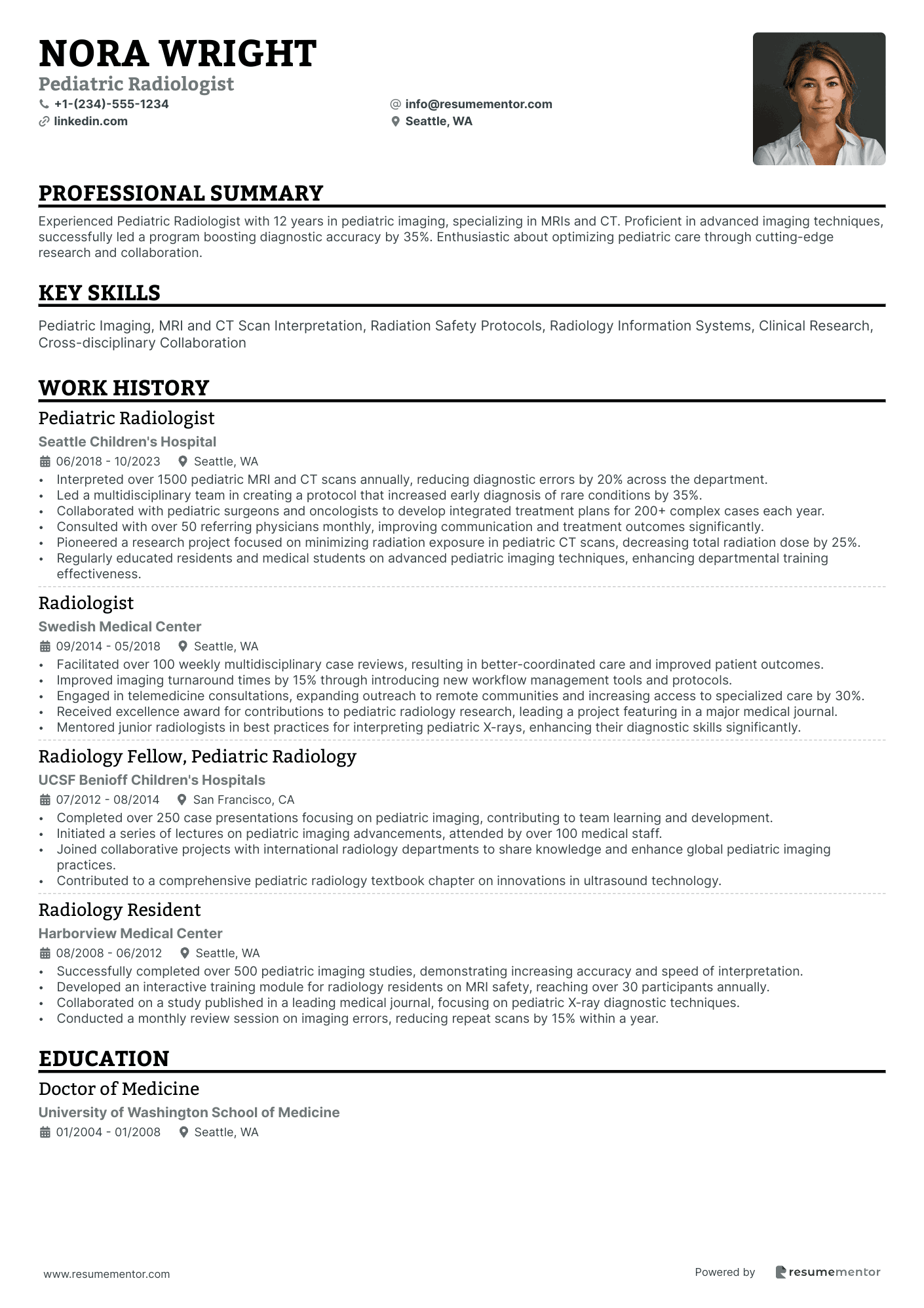
Pediatric Radiologist
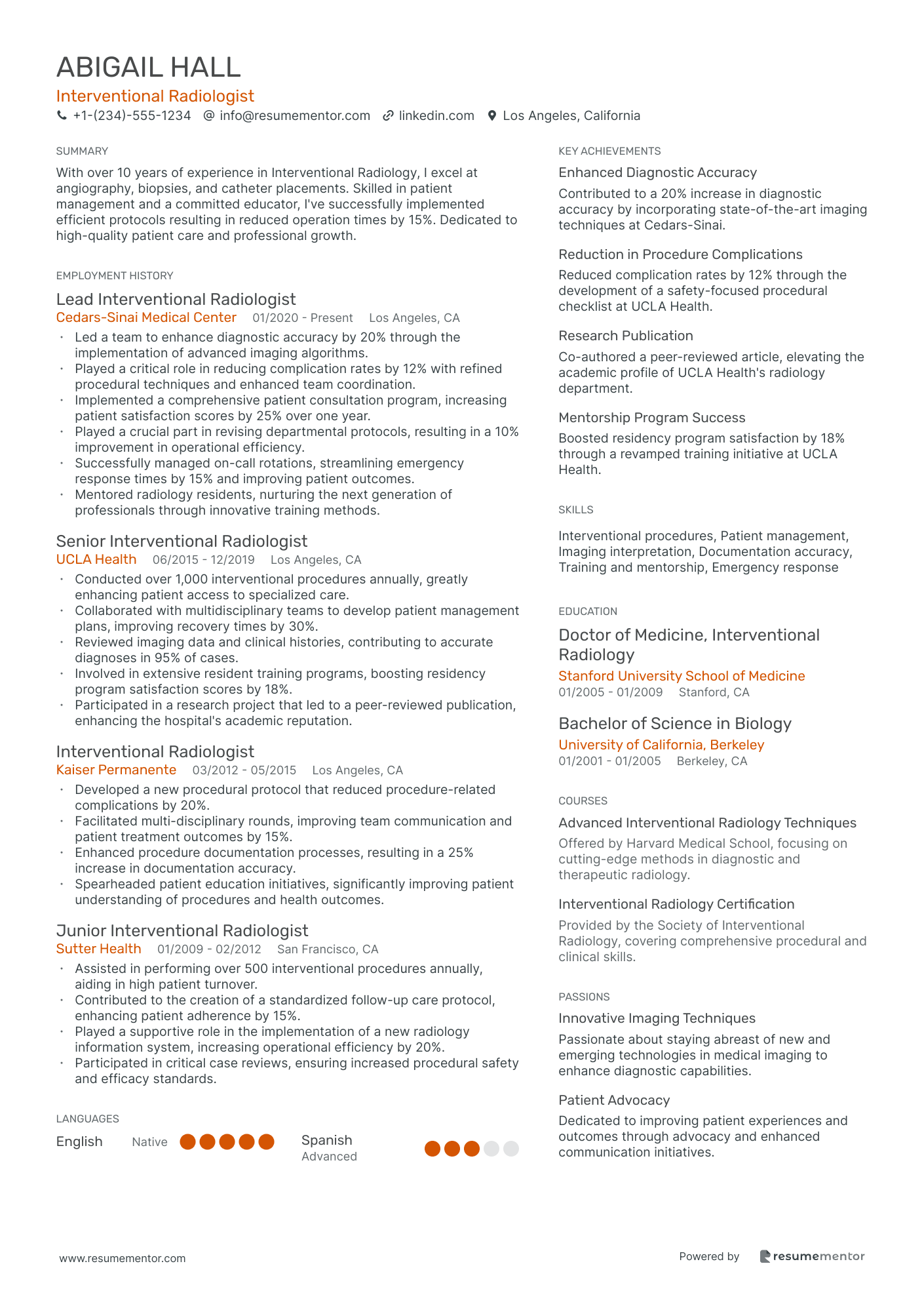
Interventional Radiologist
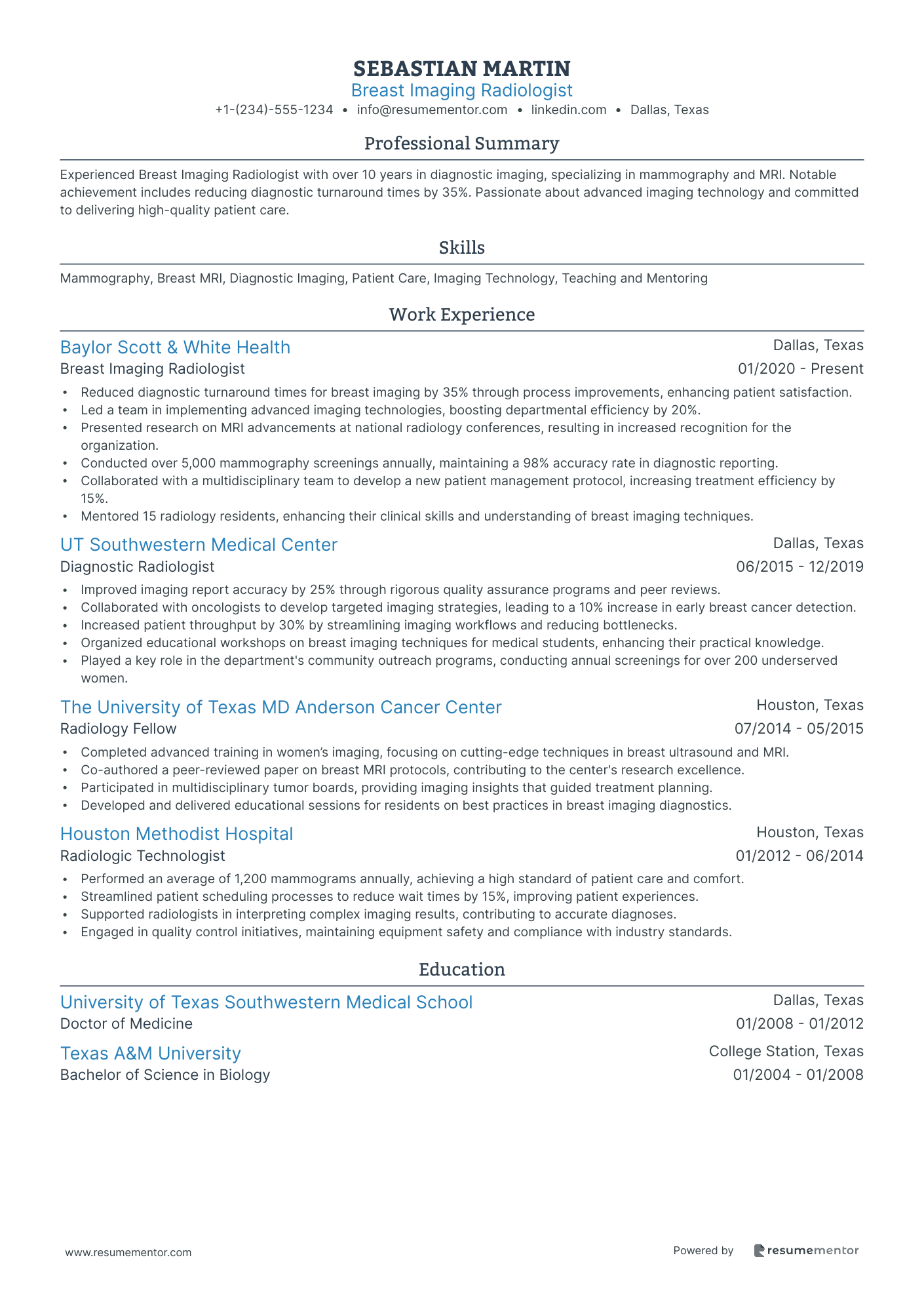
Breast Imaging Radiologist
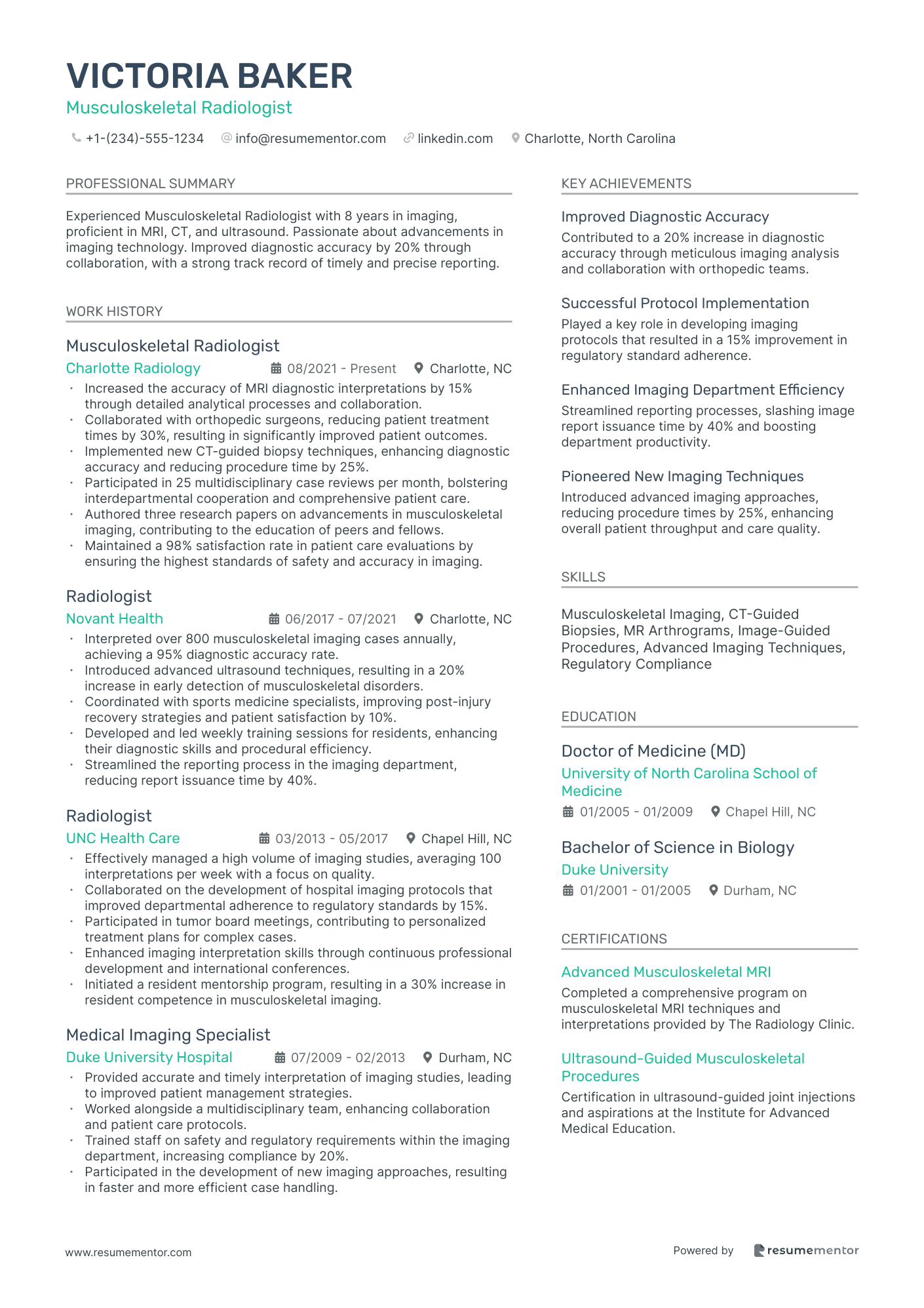
Musculoskeletal Radiologist
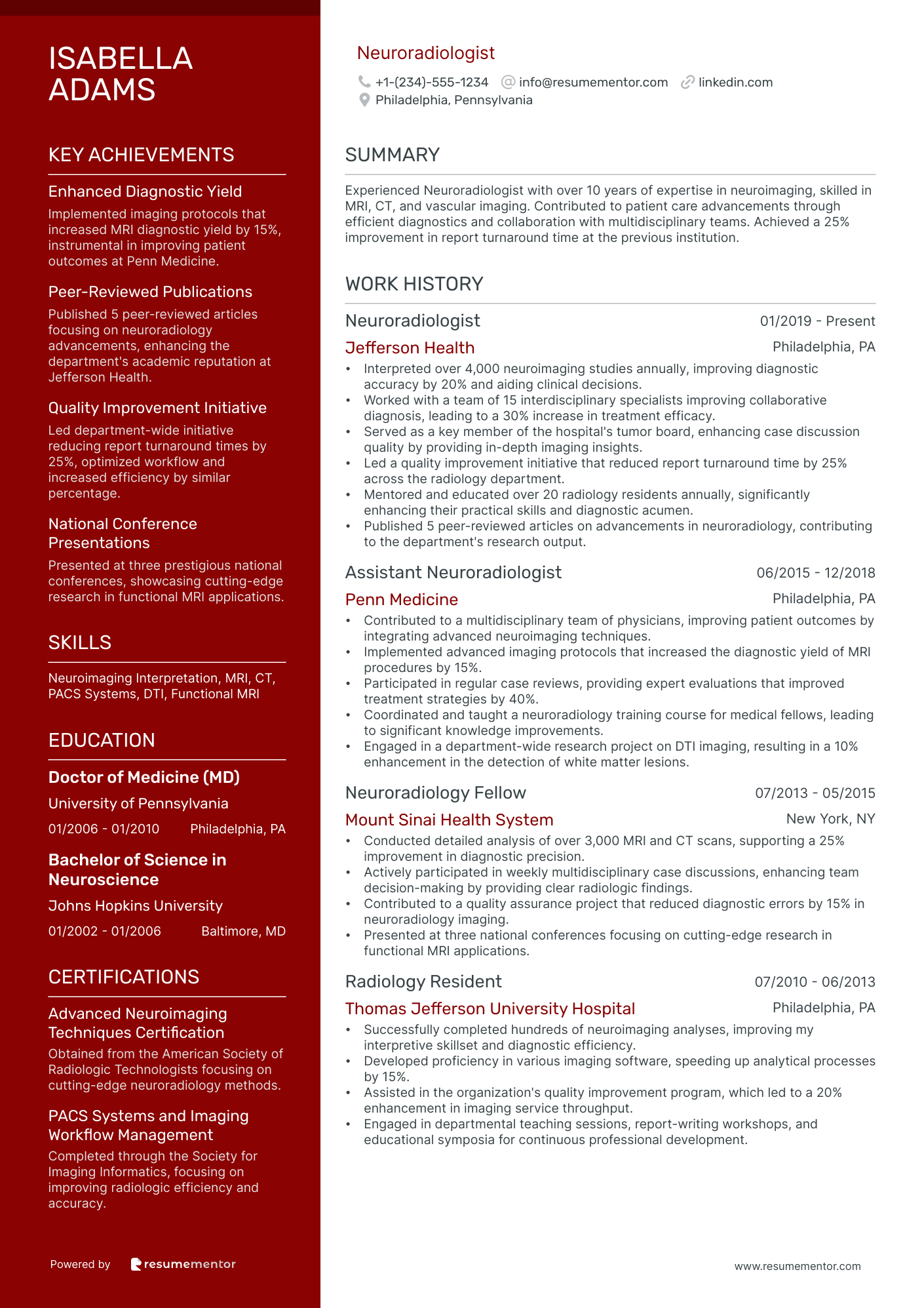
Neuroradiologist
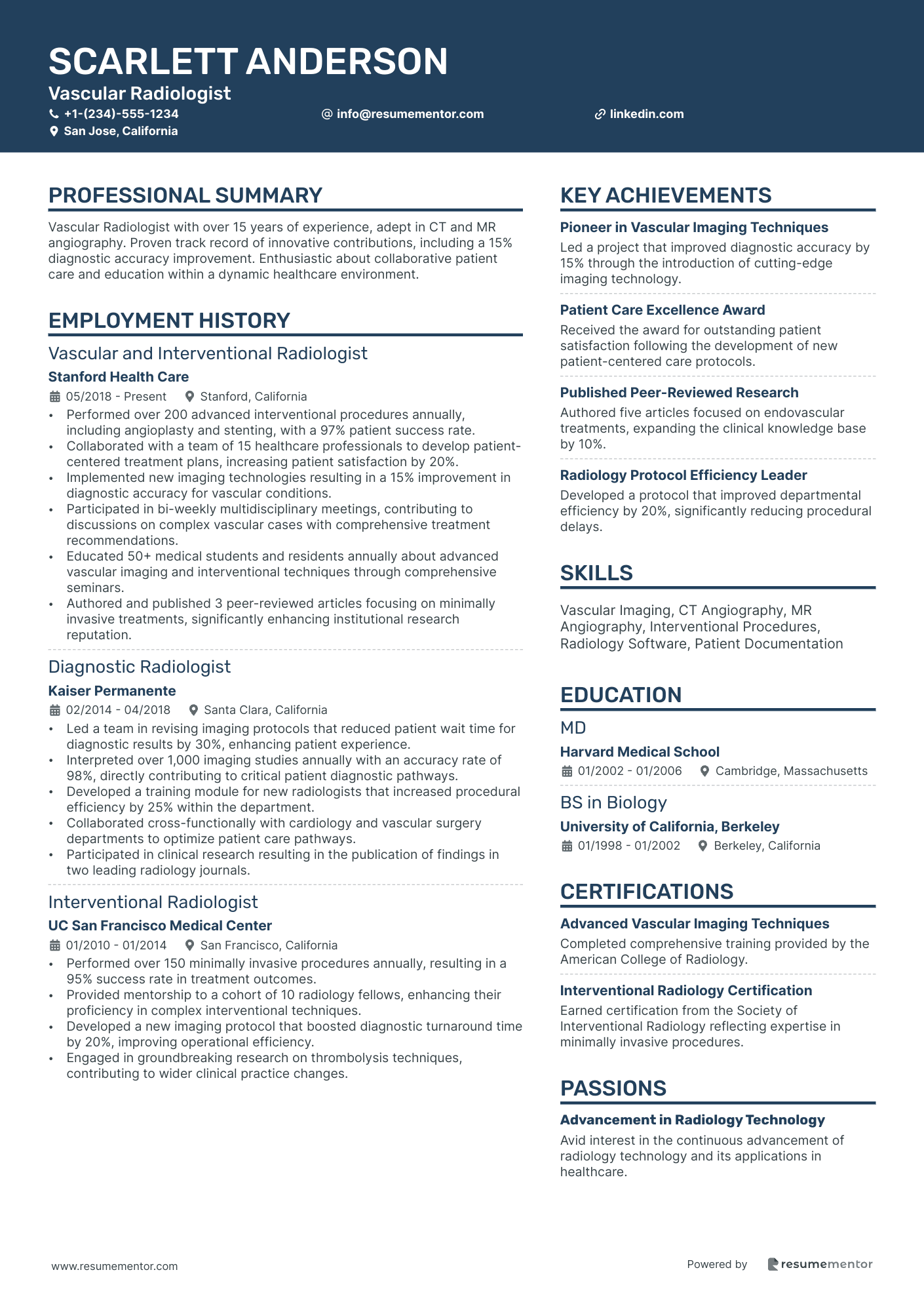
Vascular Radiologist
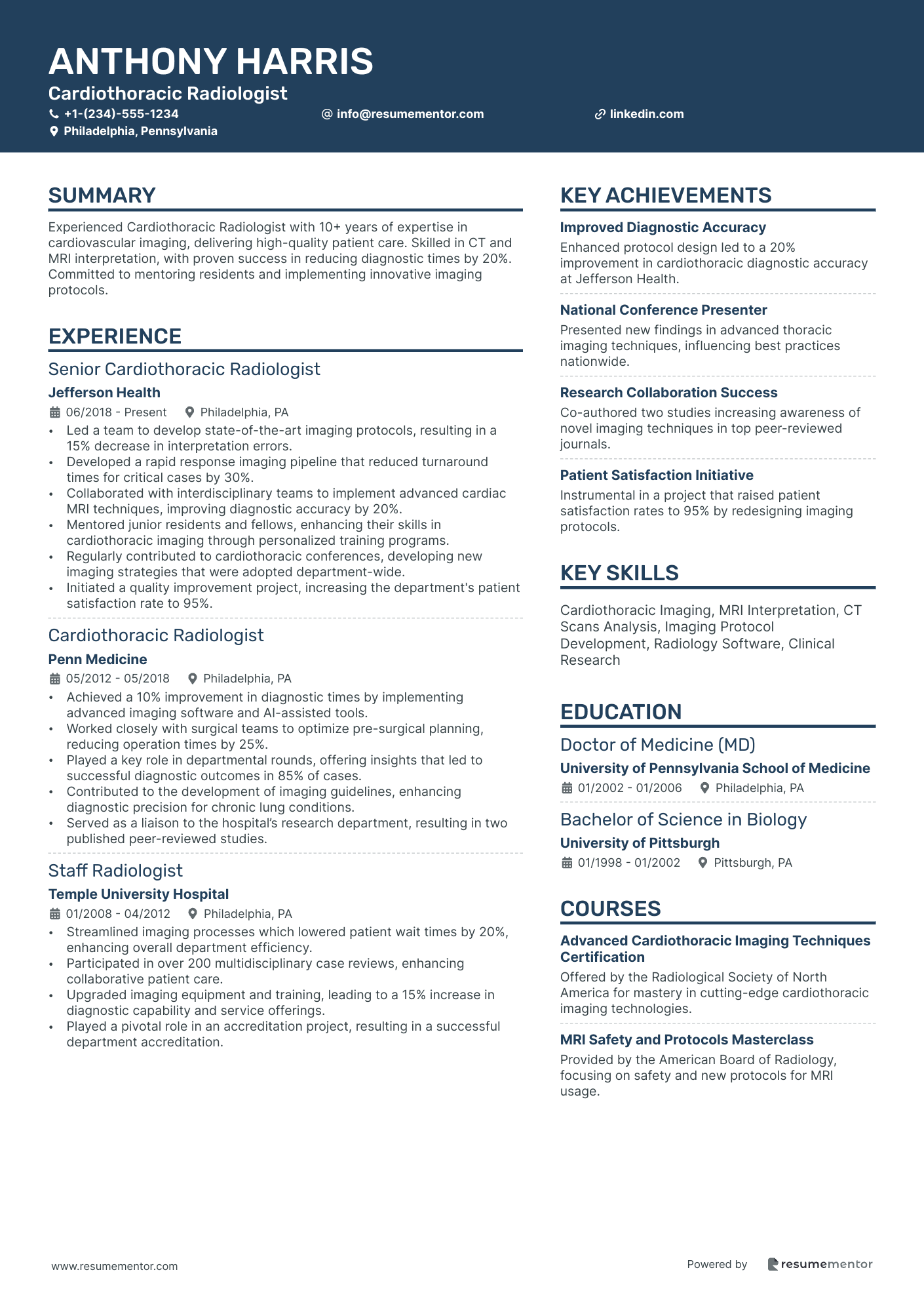
Cardiothoracic Radiologist
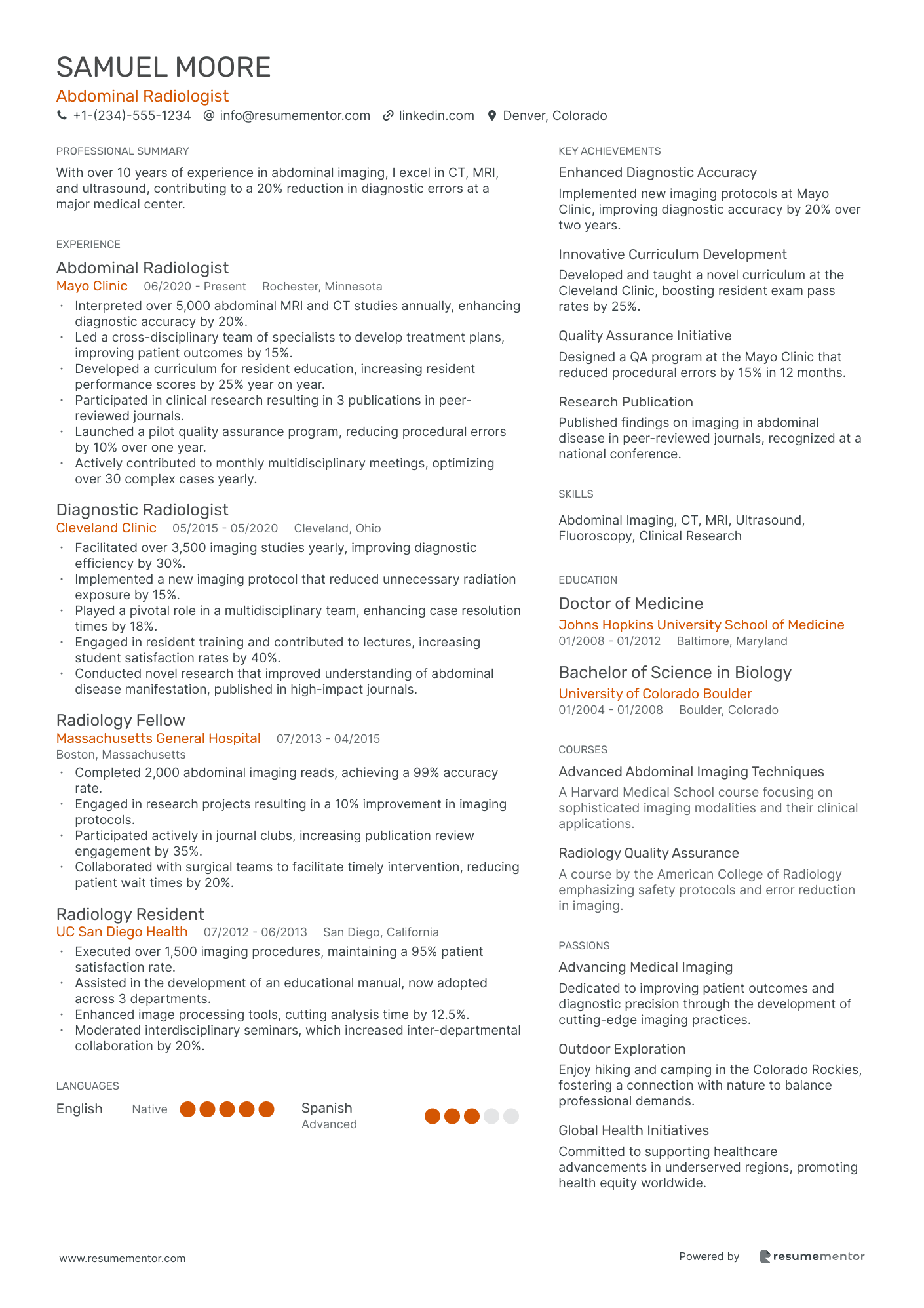
Abdominal Radiologist
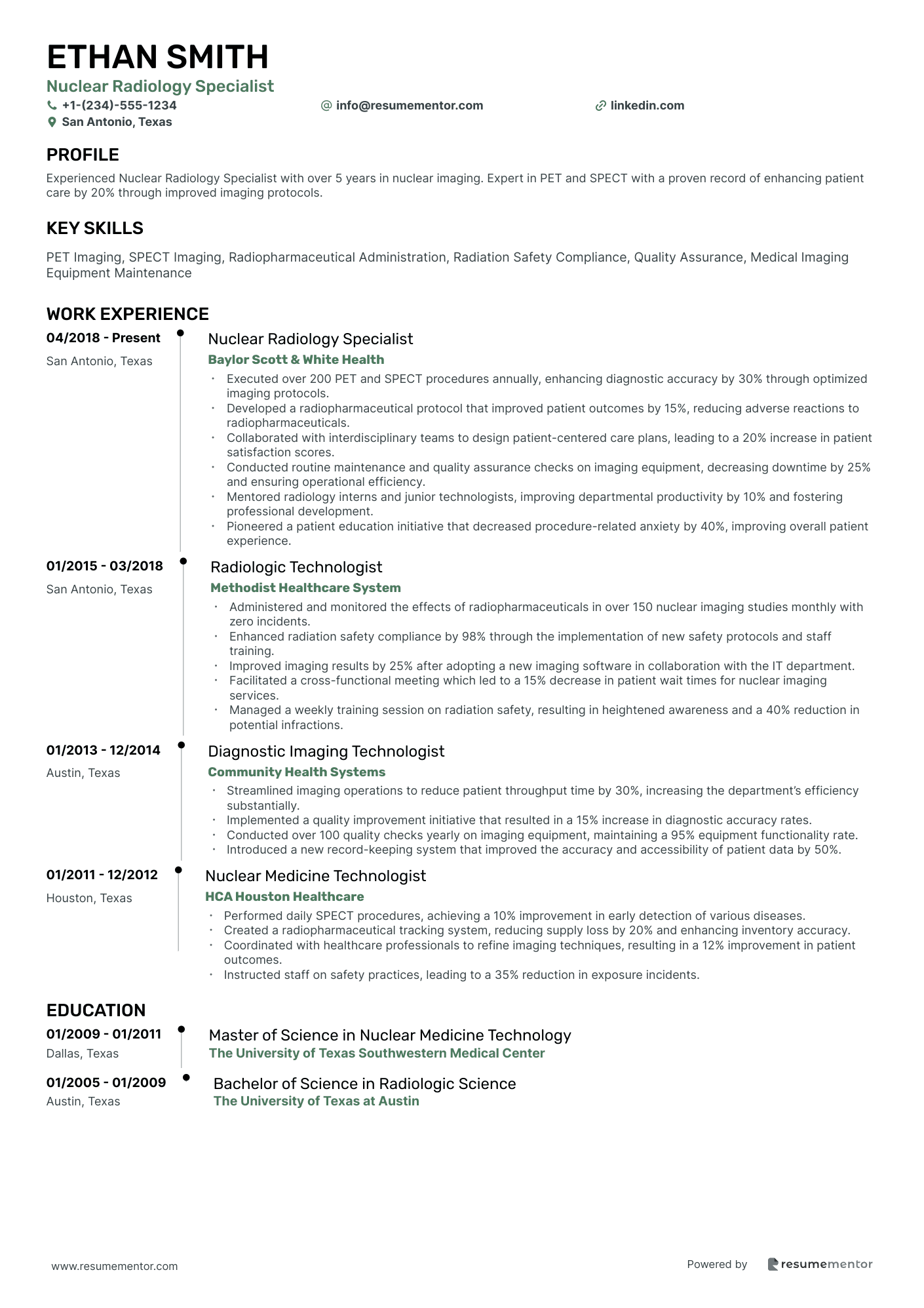
Nuclear Radiology Specialist
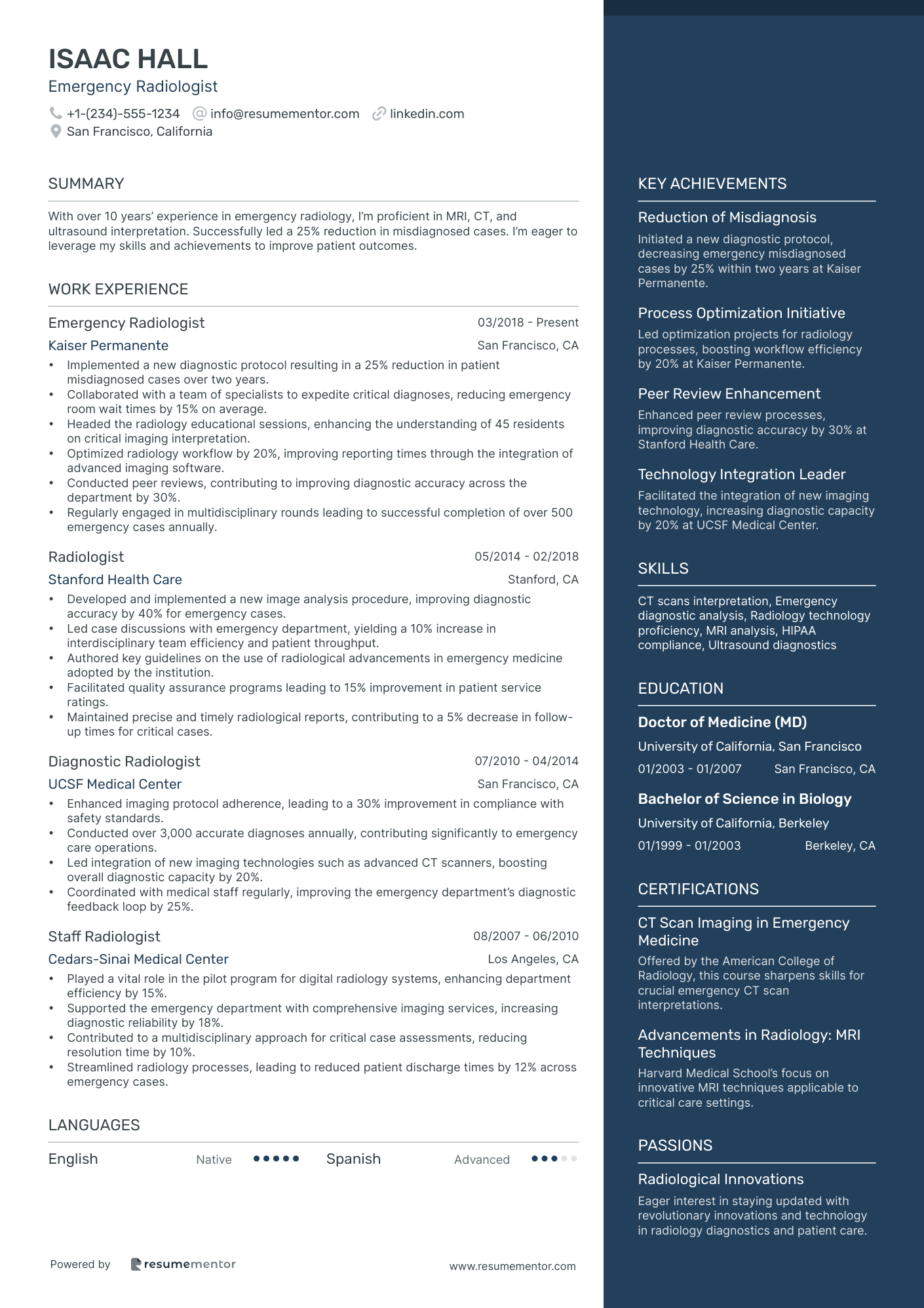
Emergency Radiologist

Pediatric Radiologist resume sample
- •Interpreted over 1500 pediatric MRI and CT scans annually, reducing diagnostic errors by 20% across the department.
- •Led a multidisciplinary team in creating a protocol that increased early diagnosis of rare conditions by 35%.
- •Collaborated with pediatric surgeons and oncologists to develop integrated treatment plans for 200+ complex cases each year.
- •Consulted with over 50 referring physicians monthly, improving communication and treatment outcomes significantly.
- •Pioneered a research project focused on minimizing radiation exposure in pediatric CT scans, decreasing total radiation dose by 25%.
- •Regularly educated residents and medical students on advanced pediatric imaging techniques, enhancing departmental training effectiveness.
- •Facilitated over 100 weekly multidisciplinary case reviews, resulting in better-coordinated care and improved patient outcomes.
- •Improved imaging turnaround times by 15% through introducing new workflow management tools and protocols.
- •Engaged in telemedicine consultations, expanding outreach to remote communities and increasing access to specialized care by 30%.
- •Received excellence award for contributions to pediatric radiology research, leading a project featuring in a major medical journal.
- •Mentored junior radiologists in best practices for interpreting pediatric X-rays, enhancing their diagnostic skills significantly.
- •Completed over 250 case presentations focusing on pediatric imaging, contributing to team learning and development.
- •Initiated a series of lectures on pediatric imaging advancements, attended by over 100 medical staff.
- •Joined collaborative projects with international radiology departments to share knowledge and enhance global pediatric imaging practices.
- •Contributed to a comprehensive pediatric radiology textbook chapter on innovations in ultrasound technology.
- •Successfully completed over 500 pediatric imaging studies, demonstrating increasing accuracy and speed of interpretation.
- •Developed an interactive training module for radiology residents on MRI safety, reaching over 30 participants annually.
- •Collaborated on a study published in a leading medical journal, focusing on pediatric X-ray diagnostic techniques.
- •Conducted a monthly review session on imaging errors, reducing repeat scans by 15% within a year.
Interventional Radiologist resume sample
- •Led a team to enhance diagnostic accuracy by 20% through the implementation of advanced imaging algorithms.
- •Played a critical role in reducing complication rates by 12% with refined procedural techniques and enhanced team coordination.
- •Implemented a comprehensive patient consultation program, increasing patient satisfaction scores by 25% over one year.
- •Played a crucial part in revising departmental protocols, resulting in a 10% improvement in operational efficiency.
- •Successfully managed on-call rotations, streamlining emergency response times by 15% and improving patient outcomes.
- •Mentored radiology residents, nurturing the next generation of professionals through innovative training methods.
- •Conducted over 1,000 interventional procedures annually, greatly enhancing patient access to specialized care.
- •Collaborated with multidisciplinary teams to develop patient management plans, improving recovery times by 30%.
- •Reviewed imaging data and clinical histories, contributing to accurate diagnoses in 95% of cases.
- •Involved in extensive resident training programs, boosting residency program satisfaction scores by 18%.
- •Participated in a research project that led to a peer-reviewed publication, enhancing the hospital's academic reputation.
- •Developed a new procedural protocol that reduced procedure-related complications by 20%.
- •Facilitated multi-disciplinary rounds, improving team communication and patient treatment outcomes by 15%.
- •Enhanced procedure documentation processes, resulting in a 25% increase in documentation accuracy.
- •Spearheaded patient education initiatives, significantly improving patient understanding of procedures and health outcomes.
- •Assisted in performing over 500 interventional procedures annually, aiding in high patient turnover.
- •Contributed to the creation of a standardized follow-up care protocol, enhancing patient adherence by 15%.
- •Played a supportive role in the implementation of a new radiology information system, increasing operational efficiency by 20%.
- •Participated in critical case reviews, ensuring increased procedural safety and efficacy standards.
Breast Imaging Radiologist resume sample
- •Reduced diagnostic turnaround times for breast imaging by 35% through process improvements, enhancing patient satisfaction.
- •Led a team in implementing advanced imaging technologies, boosting departmental efficiency by 20%.
- •Presented research on MRI advancements at national radiology conferences, resulting in increased recognition for the organization.
- •Conducted over 5,000 mammography screenings annually, maintaining a 98% accuracy rate in diagnostic reporting.
- •Collaborated with a multidisciplinary team to develop a new patient management protocol, increasing treatment efficiency by 15%.
- •Mentored 15 radiology residents, enhancing their clinical skills and understanding of breast imaging techniques.
- •Improved imaging report accuracy by 25% through rigorous quality assurance programs and peer reviews.
- •Collaborated with oncologists to develop targeted imaging strategies, leading to a 10% increase in early breast cancer detection.
- •Increased patient throughput by 30% by streamlining imaging workflows and reducing bottlenecks.
- •Organized educational workshops on breast imaging techniques for medical students, enhancing their practical knowledge.
- •Played a key role in the department's community outreach programs, conducting annual screenings for over 200 underserved women.
- •Completed advanced training in women’s imaging, focusing on cutting-edge techniques in breast ultrasound and MRI.
- •Co-authored a peer-reviewed paper on breast MRI protocols, contributing to the center's research excellence.
- •Participated in multidisciplinary tumor boards, providing imaging insights that guided treatment planning.
- •Developed and delivered educational sessions for residents on best practices in breast imaging diagnostics.
- •Performed an average of 1,200 mammograms annually, achieving a high standard of patient care and comfort.
- •Streamlined patient scheduling processes to reduce wait times by 15%, improving patient experiences.
- •Supported radiologists in interpreting complex imaging results, contributing to accurate diagnoses.
- •Engaged in quality control initiatives, maintaining equipment safety and compliance with industry standards.
Musculoskeletal Radiologist resume sample
- •Increased the accuracy of MRI diagnostic interpretations by 15% through detailed analytical processes and collaboration.
- •Collaborated with orthopedic surgeons, reducing patient treatment times by 30%, resulting in significantly improved patient outcomes.
- •Implemented new CT-guided biopsy techniques, enhancing diagnostic accuracy and reducing procedure time by 25%.
- •Participated in 25 multidisciplinary case reviews per month, bolstering interdepartmental cooperation and comprehensive patient care.
- •Authored three research papers on advancements in musculoskeletal imaging, contributing to the education of peers and fellows.
- •Maintained a 98% satisfaction rate in patient care evaluations by ensuring the highest standards of safety and accuracy in imaging.
- •Interpreted over 800 musculoskeletal imaging cases annually, achieving a 95% diagnostic accuracy rate.
- •Introduced advanced ultrasound techniques, resulting in a 20% increase in early detection of musculoskeletal disorders.
- •Coordinated with sports medicine specialists, improving post-injury recovery strategies and patient satisfaction by 10%.
- •Developed and led weekly training sessions for residents, enhancing their diagnostic skills and procedural efficiency.
- •Streamlined the reporting process in the imaging department, reducing report issuance time by 40%.
- •Effectively managed a high volume of imaging studies, averaging 100 interpretations per week with a focus on quality.
- •Collaborated on the development of hospital imaging protocols that improved departmental adherence to regulatory standards by 15%.
- •Participated in tumor board meetings, contributing to personalized treatment plans for complex cases.
- •Enhanced imaging interpretation skills through continuous professional development and international conferences.
- •Initiated a resident mentorship program, resulting in a 30% increase in resident competence in musculoskeletal imaging.
- •Provided accurate and timely interpretation of imaging studies, leading to improved patient management strategies.
- •Worked alongside a multidisciplinary team, enhancing collaboration and patient care protocols.
- •Trained staff on safety and regulatory requirements within the imaging department, increasing compliance by 20%.
- •Participated in the development of new imaging approaches, resulting in faster and more efficient case handling.
Neuroradiologist resume sample
- •Interpreted over 4,000 neuroimaging studies annually, improving diagnostic accuracy by 20% and aiding clinical decisions.
- •Worked with a team of 15 interdisciplinary specialists improving collaborative diagnosis, leading to a 30% increase in treatment efficacy.
- •Served as a key member of the hospital's tumor board, enhancing case discussion quality by providing in-depth imaging insights.
- •Led a quality improvement initiative that reduced report turnaround time by 25% across the radiology department.
- •Mentored and educated over 20 radiology residents annually, significantly enhancing their practical skills and diagnostic acumen.
- •Published 5 peer-reviewed articles on advancements in neuroradiology, contributing to the department's research output.
- •Contributed to a multidisciplinary team of physicians, improving patient outcomes by integrating advanced neuroimaging techniques.
- •Implemented advanced imaging protocols that increased the diagnostic yield of MRI procedures by 15%.
- •Participated in regular case reviews, providing expert evaluations that improved treatment strategies by 40%.
- •Coordinated and taught a neuroradiology training course for medical fellows, leading to significant knowledge improvements.
- •Engaged in a department-wide research project on DTI imaging, resulting in a 10% enhancement in the detection of white matter lesions.
- •Conducted detailed analysis of over 3,000 MRI and CT scans, supporting a 25% improvement in diagnostic precision.
- •Actively participated in weekly multidisciplinary case discussions, enhancing team decision-making by providing clear radiologic findings.
- •Contributed to a quality assurance project that reduced diagnostic errors by 15% in neuroradiology imaging.
- •Presented at three national conferences focusing on cutting-edge research in functional MRI applications.
- •Successfully completed hundreds of neuroimaging analyses, improving my interpretive skillset and diagnostic efficiency.
- •Developed proficiency in various imaging software, speeding up analytical processes by 15%.
- •Assisted in the organization's quality improvement program, which led to a 20% enhancement in imaging service throughput.
- •Engaged in departmental teaching sessions, report-writing workshops, and educational symposia for continuous professional development.
Vascular Radiologist resume sample
- •Performed over 200 advanced interventional procedures annually, including angioplasty and stenting, with a 97% patient success rate.
- •Collaborated with a team of 15 healthcare professionals to develop patient-centered treatment plans, increasing patient satisfaction by 20%.
- •Implemented new imaging technologies resulting in a 15% improvement in diagnostic accuracy for vascular conditions.
- •Participated in bi-weekly multidisciplinary meetings, contributing to discussions on complex vascular cases with comprehensive treatment recommendations.
- •Educated 50+ medical students and residents annually about advanced vascular imaging and interventional techniques through comprehensive seminars.
- •Authored and published 3 peer-reviewed articles focusing on minimally invasive treatments, significantly enhancing institutional research reputation.
- •Led a team in revising imaging protocols that reduced patient wait time for diagnostic results by 30%, enhancing patient experience.
- •Interpreted over 1,000 imaging studies annually with an accuracy rate of 98%, directly contributing to critical patient diagnostic pathways.
- •Developed a training module for new radiologists that increased procedural efficiency by 25% within the department.
- •Collaborated cross-functionally with cardiology and vascular surgery departments to optimize patient care pathways.
- •Participated in clinical research resulting in the publication of findings in two leading radiology journals.
- •Performed over 150 minimally invasive procedures annually, resulting in a 95% success rate in treatment outcomes.
- •Provided mentorship to a cohort of 10 radiology fellows, enhancing their proficiency in complex interventional techniques.
- •Developed a new imaging protocol that boosted diagnostic turnaround time by 20%, improving operational efficiency.
- •Engaged in groundbreaking research on thrombolysis techniques, contributing to wider clinical practice changes.
- •Assisted in over 500 imaging procedures under supervision, gaining specialized skills in vascular imaging interpretation.
- •Developed a resident peer education program that improved collaborative learning and engagement by 30%.
- •Contributed to institutional research projects, leading to a 10% increase in published work from the radiology department.
- •Supported senior radiologists in patient consultations, facilitating enhanced communication and patient care.
Cardiothoracic Radiologist resume sample
- •Led a team to develop state-of-the-art imaging protocols, resulting in a 15% decrease in interpretation errors.
- •Developed a rapid response imaging pipeline that reduced turnaround times for critical cases by 30%.
- •Collaborated with interdisciplinary teams to implement advanced cardiac MRI techniques, improving diagnostic accuracy by 20%.
- •Mentored junior residents and fellows, enhancing their skills in cardiothoracic imaging through personalized training programs.
- •Regularly contributed to cardiothoracic conferences, developing new imaging strategies that were adopted department-wide.
- •Initiated a quality improvement project, increasing the department's patient satisfaction rate to 95%.
- •Achieved a 10% improvement in diagnostic times by implementing advanced imaging software and AI-assisted tools.
- •Worked closely with surgical teams to optimize pre-surgical planning, reducing operation times by 25%.
- •Played a key role in departmental rounds, offering insights that led to successful diagnostic outcomes in 85% of cases.
- •Contributed to the development of imaging guidelines, enhancing diagnostic precision for chronic lung conditions.
- •Served as a liaison to the hospital’s research department, resulting in two published peer-reviewed studies.
- •Streamlined imaging processes which lowered patient wait times by 20%, enhancing overall department efficiency.
- •Participated in over 200 multidisciplinary case reviews, enhancing collaborative patient care.
- •Upgraded imaging equipment and training, leading to a 15% increase in diagnostic capability and service offerings.
- •Played a pivotal role in an accreditation project, resulting in a successful department accreditation.
- •Conducted and documented advanced imaging studies on over 500 patients, improving diagnostic outcomes.
- •Contributed to research projects focusing on thoracic imaging, with findings presented at national medical conferences.
- •Implemented new MRI techniques that reduced scan times by 10%, facilitating a higher patient throughput.
- •Developed and led training workshops for medical staff, enhancing team expertise in cardiothoracic imaging.
Abdominal Radiologist resume sample
- •Interpreted over 5,000 abdominal MRI and CT studies annually, enhancing diagnostic accuracy by 20%.
- •Led a cross-disciplinary team of specialists to develop treatment plans, improving patient outcomes by 15%.
- •Developed a curriculum for resident education, increasing resident performance scores by 25% year on year.
- •Participated in clinical research resulting in 3 publications in peer-reviewed journals.
- •Launched a pilot quality assurance program, reducing procedural errors by 10% over one year.
- •Actively contributed to monthly multidisciplinary meetings, optimizing over 30 complex cases yearly.
- •Facilitated over 3,500 imaging studies yearly, improving diagnostic efficiency by 30%.
- •Implemented a new imaging protocol that reduced unnecessary radiation exposure by 15%.
- •Played a pivotal role in a multidisciplinary team, enhancing case resolution times by 18%.
- •Engaged in resident training and contributed to lectures, increasing student satisfaction rates by 40%.
- •Conducted novel research that improved understanding of abdominal disease manifestation, published in high-impact journals.
- •Completed 2,000 abdominal imaging reads, achieving a 99% accuracy rate.
- •Engaged in research projects resulting in a 10% improvement in imaging protocols.
- •Participated actively in journal clubs, increasing publication review engagement by 35%.
- •Collaborated with surgical teams to facilitate timely intervention, reducing patient wait times by 20%.
- •Executed over 1,500 imaging procedures, maintaining a 95% patient satisfaction rate.
- •Assisted in the development of an educational manual, now adopted across 3 departments.
- •Enhanced image processing tools, cutting analysis time by 12.5%.
- •Moderated interdisciplinary seminars, which increased inter-departmental collaboration by 20%.
Nuclear Radiology Specialist resume sample
- •Executed over 200 PET and SPECT procedures annually, enhancing diagnostic accuracy by 30% through optimized imaging protocols.
- •Developed a radiopharmaceutical protocol that improved patient outcomes by 15%, reducing adverse reactions to radiopharmaceuticals.
- •Collaborated with interdisciplinary teams to design patient-centered care plans, leading to a 20% increase in patient satisfaction scores.
- •Conducted routine maintenance and quality assurance checks on imaging equipment, decreasing downtime by 25% and ensuring operational efficiency.
- •Mentored radiology interns and junior technologists, improving departmental productivity by 10% and fostering professional development.
- •Pioneered a patient education initiative that decreased procedure-related anxiety by 40%, improving overall patient experience.
- •Administered and monitored the effects of radiopharmaceuticals in over 150 nuclear imaging studies monthly with zero incidents.
- •Enhanced radiation safety compliance by 98% through the implementation of new safety protocols and staff training.
- •Improved imaging results by 25% after adopting a new imaging software in collaboration with the IT department.
- •Facilitated a cross-functional meeting which led to a 15% decrease in patient wait times for nuclear imaging services.
- •Managed a weekly training session on radiation safety, resulting in heightened awareness and a 40% reduction in potential infractions.
- •Streamlined imaging operations to reduce patient throughput time by 30%, increasing the department’s efficiency substantially.
- •Implemented a quality improvement initiative that resulted in a 15% increase in diagnostic accuracy rates.
- •Conducted over 100 quality checks yearly on imaging equipment, maintaining a 95% equipment functionality rate.
- •Introduced a new record-keeping system that improved the accuracy and accessibility of patient data by 50%.
- •Performed daily SPECT procedures, achieving a 10% improvement in early detection of various diseases.
- •Created a radiopharmaceutical tracking system, reducing supply loss by 20% and enhancing inventory accuracy.
- •Coordinated with healthcare professionals to refine imaging techniques, resulting in a 12% improvement in patient outcomes.
- •Instructed staff on safety practices, leading to a 35% reduction in exposure incidents.
Emergency Radiologist resume sample
- •Implemented a new diagnostic protocol resulting in a 25% reduction in patient misdiagnosed cases over two years.
- •Collaborated with a team of specialists to expedite critical diagnoses, reducing emergency room wait times by 15% on average.
- •Headed the radiology educational sessions, enhancing the understanding of 45 residents on critical imaging interpretation.
- •Optimized radiology workflow by 20%, improving reporting times through the integration of advanced imaging software.
- •Conducted peer reviews, contributing to improving diagnostic accuracy across the department by 30%.
- •Regularly engaged in multidisciplinary rounds leading to successful completion of over 500 emergency cases annually.
- •Developed and implemented a new image analysis procedure, improving diagnostic accuracy by 40% for emergency cases.
- •Led case discussions with emergency department, yielding a 10% increase in interdisciplinary team efficiency and patient throughput.
- •Authored key guidelines on the use of radiological advancements in emergency medicine adopted by the institution.
- •Facilitated quality assurance programs leading to 15% improvement in patient service ratings.
- •Maintained precise and timely radiological reports, contributing to a 5% decrease in follow-up times for critical cases.
- •Enhanced imaging protocol adherence, leading to a 30% improvement in compliance with safety standards.
- •Conducted over 3,000 accurate diagnoses annually, contributing significantly to emergency care operations.
- •Led integration of new imaging technologies such as advanced CT scanners, boosting overall diagnostic capacity by 20%.
- •Coordinated with medical staff regularly, improving the emergency department’s diagnostic feedback loop by 25%.
- •Played a vital role in the pilot program for digital radiology systems, enhancing department efficiency by 15%.
- •Supported the emergency department with comprehensive imaging services, increasing diagnostic reliability by 18%.
- •Contributed to a multidisciplinary approach for critical case assessments, reducing resolution time by 10%.
- •Streamlined radiology processes, leading to reduced patient discharge times by 12% across emergency cases.
Navigating the world of radiology demands precision and clarity, much like crafting your radiologist resume. With your skills in interpreting complex medical images, transforming that expertise onto paper can be equally intricate. Your resume is your first connection with potential employers, a crucial key that opens doors to career opportunities.
Effectively conveying your radiology achievements and skills in a concise manner is vital, yet often challenging. This is where using a resume template plays a significant role. A structured template ties together your experience, ensuring your resume looks both professional and organized.
With the right template, you can focus on weaving in your unique strengths, such as advanced imaging techniques and diagnostic precision. This seamless presentation aligns your capabilities with what employers seek in the competitive radiology field, keeping your skills front and center.
Whether you're an experienced radiologist or just starting out, maintaining a polished, up-to-date resume is essential. It’s not just a reflection of your past, but a tool to propel you forward in your career journey.
Key Takeaways
- Using a structured resume template is crucial to effectively convey your radiology achievements and ensure a professional presentation.
- Employers value a resume that highlights unique strengths such as advanced imaging techniques and diagnostic precision, presented in a chronological format.
- A strong resume experience section should emphasize quantifiable achievements, impactful contributions, and use of action verbs.
- A carefully crafted summary can captivate employers from the start, showcasing your qualifications and what makes you a valuable candidate.
- Including extra sections like languages, volunteer work, and ongoing education can enhance your resume and set you apart from others.
What to focus on when writing your radiologist resume
A radiologist resume should effectively convey your expertise in medical imaging and diagnostic skills to the recruiter—It’s important to reflect your experience clearly, showing your proficiency in interpreting medical images and your ability to work well with healthcare teams.
How to structure your radiologist resume
- Contact Information: Start with adding your full name, phone number, email, and LinkedIn profile—These ensure recruiters can easily reach you. Be precise and professional, ensuring there are no errors or outdated information, as first impressions begin here.
- Professional Summary: Craft a concise overview of your radiology career, demonstrating your specializations, unique skills, and certifications—This serves as your elevator pitch, providing a snapshot of why you’re an excellent fit for a radiologist position.
- Skills: List critical skills relevant to radiology, like your expertise in interpreting MRI, CT, and ultrasound images—Emphasize your ability to handle radiological equipment and how you communicate complex findings to other healthcare professionals.
- Experience: Provide descriptions of your roles in medical imaging, with a focus on any advancements or improvements you've contributed to in patient care and diagnoses—Use quantifiable achievements where possible to underscore your impact.
- Education: Detail your academic journey, including your medical degree and specialized radiology training—Highlight the institutions and any honors to lend credibility and context to your background.
- Licenses and Certifications: Mention your board certification alongside any state-specific radiology licenses—Include certifications like Advanced Cardiac Life Support (ACLS) if applicable, solidifying your qualifications.
For a well-rounded approach to writing a radiologist resume, also consider sections like "Research and Publications" or "Professional Affiliations" that further illustrate your professional achievements and involvement—Below, we'll cover each section more in-depth to enhance your resume format.
Which resume format to choose
Creating an effective radiologist resume starts with choosing the right format to best showcase your skills and experience. In the healthcare field, particularly for radiologists, a chronological format is highly effective. This format clearly outlines your work history and career progression, which helps potential employers quickly grasp your professional journey and the depth of your experience.
The visual impact of your resume can significantly influence its effectiveness. Selecting modern, clean fonts like Rubik, Montserrat, or Raleway can set you apart from others who might still rely on outdated styles. These fonts contribute to a polished appearance without distracting from the content of your resume.
To ensure the integrity of your resume's design, always save it as a PDF. PDFs preserve your carefully formatted layout, ensuring that your document appears the same across all devices and platforms, which is crucial for maintaining a professional image.
Attention to detail in your resume's format is important, which includes setting appropriate margins. A one-inch margin on all sides creates a professional and organized appearance, allowing for plenty of white space. This not only makes your resume easier to read but also helps keep the focus on the key details of your qualifications.
Through these strategic choices, your radiologist resume will effectively communicate your expertise and suitability for the role, making you stand out in a competitive field.
How to write a quantifiable resume experience section
Sure, here's a more connected version:
To craft a compelling radiologist experience section, emphasize how your technical expertise has led to improvements in patient outcomes and clinic efficiency. This part of your resume provides a snapshot of your skills and achievements, helping employers visualize your potential impact. Start with your most recent job experiences, listing them in reverse chronological order to show your career progression clearly. When detailing experiences from the past 10-15 years, focus on roles that closely match the job you're applying for. Tailor your resume by weaving in keywords from the job ad and highlighting measurable achievements. Use action verbs such as "analyzed," "optimized," "improved," and "collaborated" to make your contributions stand out.
- •Boosted diagnostic accuracy by 15% by implementing advanced imaging technologies.
- •Guided a team of 10 radiologists, cutting report turnaround time by 25%.
- •Teamed up with interdisciplinary groups, enhancing patient satisfaction scores by 20%.
- •Streamlined radiology department processes, slashing patient wait times by 30%.
This experience section smoothly intertwines your accomplishments by demonstrating how you've consistently brought about positive changes. The clear progression of responsibilities and innovations further emphasizes your leadership and effectiveness in the imaging field. Specific metrics, such as improved diagnostic accuracy and reduced wait times, are not just numbers—they showcase your ability to enact significant changes. By aligning each point with the skills valued by employers, you provide concrete examples that match the needs outlined in radiologist job listings, effectively connecting your experiences with prospective job roles.
Problem-Solving Focused resume experience section
A problem-solving focused radiologist resume experience section should clearly demonstrate your capability to interpret diagnostic images and improve patient outcomes. Begin by showcasing specific technologies, methodologies, or results that highlight your problem-solving skills. Share concrete examples of challenges you've faced, detailing the actions you took and the positive impact of your solutions, which will help you tell a compelling story of your contributions.
Organize your experience using bullet points to ensure easy reading for potential employers. Each bullet should connect logically to the next, focusing on key areas like accuracy, efficiency, and collaboration. Highlight how your teamwork with interdisciplinary teams enhances patient care, drawing attention to your versatile skills. By presenting distinct aspects such as patient interaction, technical expertise, and problem-solving, you create a cohesive narrative of your abilities as a radiologist.
Senior Radiologist
Advanced Diagnostic Imaging Center
2019-2023
- Streamlined workflow processes, cutting image interpretation time by 15%, which accelerated patient diagnosis.
- Applied advanced MRI techniques to improve diagnostic accuracy for complex musculoskeletal conditions, enhancing treatment plans.
- Collaborated closely with a multidisciplinary team to establish new protocols, boosting patient satisfaction scores by 20% through enhanced care practices.
- Designed and implemented a training program for junior radiologists, elevating team efficiency and diagnostic skills across the department.
Training and Development Focused resume experience section
A training and development-focused radiologist resume experience section should effectively highlight your role in enhancing skills and knowledge within the field. Begin by identifying key accomplishments that emphasize your ability to mentor and guide others. Consider training programs you've developed or improved, focusing on the hurdles you faced and how you overcame them. Concrete examples, such as improved test scores or successful training module completions, will illustrate your impact on your colleagues.
Next, weave these achievements into a seamless and engaging narrative. Highlight the outcomes and benefits your efforts brought to your team or workplace. Ensure each bullet point clearly underscores a specific responsibility or achievement, using simple and direct language. This approach will help the reader quickly understand your capabilities and experiences, distinguishing you from others in the field.
Training Coordinator
Metro Health Radiology
June 2019 - Present
- Led the development of a comprehensive radiologic skills training program, boosting staff certification pass rates by 30%.
- Organized monthly workshops on the latest radiology technologies, enhancing team skills.
- Mentored junior radiologists, which led to improved diagnostic accuracy in peer reviews.
- Created a digital resource library for 24/7 access to educational materials, improving knowledge retention.
Collaboration-Focused resume experience section
A collaboration-focused radiologist resume experience section should seamlessly showcase your ability to work effectively with other healthcare professionals. Begin by sharing experiences that involve coordinating with specialists, nurses, and support staff, emphasizing how these partnerships have led to improved patient outcomes and smoother operations. Highlight specific projects you have led or contributed to that resulted in enhanced team efficiency and better patient care.
Illustrate how you communicate complex medical information in a clear manner to both medical and non-medical team members. Emphasize collaborative efforts that have resulted in more accurate diagnoses and effective treatment plans. Use quantifiable achievements, such as reducing report turnaround time or improving patient satisfaction, to demonstrate success. By focusing on these interconnected elements, you will craft a compelling narrative that appeals to potential employers.
Lead Radiologist
City Hospital
June 2018 - Present
- Collaborated with a multidisciplinary team to reduce diagnostic errors by 20%.
- Led weekly meetings with specialists to discuss complex cases, enhancing treatment plans.
- Streamlined reporting processes, improving turnaround times by 15%.
- Mentored junior radiologists, fostering a culture of teamwork and learning.
Achievement-Focused resume experience section
A radiologist achievement-focused resume experience section should clearly highlight your accomplishments and their direct impact on patient care and team efficiency. Start by choosing action verbs like "diagnosed," "analyzed," or "executed" to effectively describe your tasks. Including metrics and data helps to illustrate measurable outcomes, such as improvements in diagnostic accuracy or the number of patients supported. This approach also showcases your unique skills and technologies you've utilized, which is especially compelling for potential employers.
Demonstrating how your contributions benefited the team or patient outcomes adds significant value. Use bullet points to convey these achievements in a clear and concise manner, focusing on how your efforts made a difference. Tailoring each job description to emphasize skills and experiences that future employers would find valuable is key to making a strong impression.
Diagnostic Radiologist
City Hospital
January 2018 - Present
- Led the implementation of advanced imaging protocols, decreasing diagnostic error rates by 15%
- Interpreted an average of 100 complex radiological exams each month with 99% accuracy
- Collaborated with a multidisciplinary team to develop patient-specific treatment plans, speeding up recovery time by 20%
- Conducted training sessions for junior radiologists, boosting departmental efficiency
Write your radiologist resume summary section
A radiologist-focused resume experience section should begin with a compelling summary that highlights your core skills, experience, and what makes you unique. This part of your resume is crucial for grabbing the employer's attention from the start. If you’re an experienced radiologist, you should emphasize your time in the field, specializations, and notable achievements. For instance, you might write something like:
This type of summary works well because it clearly highlights your qualifications and contributions, making it easy for employers to see your value. By providing concrete examples of your skills in radiology, you help employers envision you as a vital addition to their team. For those with less experience, a resume objective might be more suitable. A resume objective focuses on your aspirations and what you aim to achieve in the role, contrasting with a summary or profile that emphasizes past accomplishments. Alternatively, you could include a summary of qualifications, offering a bullet-pointed list of core skills as a quick snapshot of your abilities. Ultimately, choosing the right section depends on your experience level and the message you want to convey. A well-crafted summary or objective sets a positive tone and piques employers' interest to learn more about you.
Listing your radiologist skills on your resume
A radiologist-focused resume should seamlessly integrate your skills throughout its sections, including the experience and summary, or highlight them in a dedicated skills section. By showcasing your strengths and soft skills, you illuminate personal attributes like communication and teamwork, setting the stage for a well-rounded impression. Hard skills, distinct from soft skills, encompass specific technical abilities acquired through practice and education, such as proficiency in diagnostic imaging techniques.
In the resume world, skills and strengths are more than mere additions; they serve as critical resume keywords. Recruiters and Applicant Tracking Systems (ATS) often scan for these keywords to identify standout candidates. Emphasizing key skills in your resume ensures it aligns with job requirements, grabbing attention and opening doors.
Here's how a well-crafted standalone skills section might look:
This example demonstrates precision in selecting skills specific to radiology, painting a clear picture of your competencies. Each skill is relevant, strengthening your resume by showcasing both technical expertise and patient interaction capabilities.
Best hard skills to feature on your radiologist resume
To exhibit your technical expertise, hard skills should demonstrate your ability to carry out various diagnostic imaging tasks. These skills confirm your proficiency with the equipment and protocols vital for accurate patient diagnostics.
Hard Skills
- Radiologic Imaging
- MRI Interpretation
- CT Scans
- Ultrasound Proficiency
- Mammography
- Nuclear Medicine
- Interventional Radiology
- Image Analysis
- PACS System Efficiency
- Radiation Safety
- Fluoroscopy
- DEXA Scanning
- Teleradiology
- Image Processing Software
- Quality Control
Best soft skills to feature on your radiologist resume
Soft skills highlight essential personal attributes that enhance patient care and teamwork. They reflect your ability to communicate, solve problems, and empathize with others, enriching both patient interactions and team dynamics.
Soft Skills
- Communication
- Attention to Detail
- Empathy
- Problem-Solving
- Team Collaboration
- Emotional Intelligence
- Time Management
- Professionalism
- Adaptability
- Decision-Making
- Patient Care
- Conflict Resolution
- Active Listening
- Patience
- Stress Management
How to include your education on your resume
The education section of your resume is crucial, especially for a radiologist. This section needs to be focused and tailored to the job, highlighting relevant qualifications while leaving out anything unrelated. List your degrees prominently; your medical degree should be most important. Including your GPA in your education section is optional but can be beneficial if it is strong. It is best to use the format “GPA: X.XX/4.00” if choosing to include it. If you graduated with honors such as cum laude, include this right next to your degree title to showcase your academic achievements.
The second example is good because it directly relates to the role of a radiologist. It features degrees in medicine and a strong GPA in a relevant undergraduate program. Presenting your academic achievements like graduating cum laude emphasizes your dedication to excellence. The inclusion of dates presents a concise timeline of your academic journey, an essential component for clarity. Tailoring content tailored to the relevant field with clean formatting can greatly impress potential employers.
How to include radiologist certificates on your resume
Including a certificates section in your radiologist resume is crucial. List the name of each certificate you have earned. Include the date when you obtained it. Add the issuing organization to showcase credibility. Certificates can also be included in the header for quick visibility.
Here's how a good standalone certificates section looks:
This example demonstrates a focused and relevant collection of certificates for a radiologist. It clearly identifies the professional certifications with recognizable and reputable issuers. The inclusion of the certifying bodies enhances the authority of the qualifications.
A well-structured certificates section ensures that hiring managers quickly recognize your qualifications, making it an essential part of your resume.
Extra sections to include in your radiologist resume
Crafting a standout resume as a radiologist involves more than just listing your education and work experience. To truly shine, you should include additional sections that showcase your diverse skills, personality, and community involvement.
Language section — List any additional languages you speak. Highlighting your multilingual skills can make you a more versatile and valuable candidate for hospitals and clinics with diverse patient populations.
Hobbies and interests section — Mention hobbies that show valuable skills or qualities, such as photography or sports. This section can make you relatable and provide conversation starters during your interviews.
Volunteer work section — Include volunteer activities, especially those related to healthcare. Demonstrating your commitment to community service can emphasize your compassionate and altruistic nature.
Books section — Add books you've read that are relevant to your field, like radiology textbooks or medical journals. This shows your dedication to ongoing education and staying updated with the latest advancements in radiology.
In Conclusion
In conclusion, as you navigate the competitive field of radiology, your resume stands as a crucial representation of your professional journey and capabilities. It's not just about listing credentials but about effectively communicating your unique strengths and achievements. A well-organized resume showcases your expertise in diagnostic imaging, emphasizes your problem-solving skills, and highlights your ability to collaborate within multidisciplinary teams. By utilizing modern, clean formats and adhering to effective design principles, your resume will maintain a polished appearance.
Incorporate quantifiable accomplishments to provide employers with concrete evidence of your contributions and potential impact. The inclusion of personal and technical skills throughout your resume further strengthens your profile, aligning with both recruiter expectations and automated scanning systems. Don't overlook the power of additional sections like language proficiency, hobbies, and volunteer work, which collectively paint a picture of you as a comprehensive and compassionate candidate.
As you curate each section, remember that authenticity and clarity are your best allies. Through thoughtful presentation, your resume will effectively speak to your dedication and readiness to thrive in the radiology field. Ultimately, a resume that resonates with employers is one that balances professionalism with personal flair, capturing both the mind and heart of the recruiter. With these strategic approaches, you position yourself to open doors to new possibilities and further your career as a radiologist.
Related Articles

Continue Reading
Check more recommended readings to get the job of your dreams.
Resume
Resources
Tools
© 2025. All rights reserved.
Made with love by people who care.

